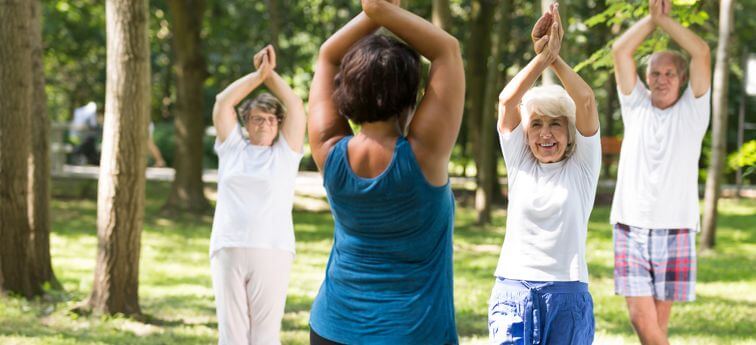
What You'll Learn

The baby boomer generation is changing the face of aging, and teaching younger generations that growing older doesn’t have to mean growing sicker or moving slower. One way boomers are leading the charge of healthy aging is by choosing to remain active throughout retirement. While some are running marathons or lifting weights, other seniors are falling in love with the ancient practice of yoga.
Yoga is great for people of all ages, including seniors. Thanks to a variety of adaptations and props, yogis can participate no matter their mobility, flexibility, or strength. Here are a few benefits of yoga for seniors:
Increased Flexibility
Yoga practice increases flexibility of the practitioner. Seniors with increased flexibility can have a decreased rate of injury due to falls, and can recover more quickly from other injuries or pain.
Better Balance
Naturally, our balance suffers as we age. When seniors participate in yoga, they are actively working on their balance, even if they are not standing on one foot during Tree Pose. Seniors with better balance are less likely to fall.
Body Awareness
Throughout each yoga class, seniors are cued to pay attention to specific parts of their bodies. This body awareness can translate to decreased falls, as well as increased awareness of when they are fatigued or ill.
Brain Activity
Taking a yoga class brings more than just physical benefits. Most yoga asanas, or poses, involve reaching an arm across the body. This is called “crossing the midline” and has shown to increase brain activity and coordination.
Increased Strength and Endurance
Yoga, while gentle and beginner friendly, is intensely focused on building strong muscles. Participating in classes can increase strength and endurance for all parts of the body, which can lead to a healthy body mass index and efficient metabolism.
Decreased Pain
For many senior yogis, regular classes mean decreased pain. People living with arthritis may enjoy classes in a slightly heated room (not too hot, but just enough to provide relief for stiff joints), while those living with chronic back pain can enjoy relief thanks to better posture and alignment.
Increased Mindfulness and Relaxation
One of the biggest benefits of yoga for seniors—and practitioners of all ages—is the relaxation that comes with the focused movement. Because yogis are focused on their movement only, they are practicing mindfulness and living in the moment. This can increase feelings of peace, calm, and even happiness by the end of a class. Better yet, students are encouraged to take that practice off their mat and into their life at home. Increased feelings of calm can lead to decreased stress or feelings of anxiety.
Practicing Safely
If you are considering beginning a yoga practice, talk to your physician first. Your doctor can give you any precautions to consider as you start your practice. After you are medically cleared, search for classes near you that are geared toward seniors. Yoga teachers can be specially trained for senior body mechanics, which means your class will be safer and led by a teacher who knows about conditions like osteoarthritis and osteoporosis. You should also search for a teacher that encourages the correct use of props, like straps, blocks, or chairs. Using these props helps beginners maintain correct alignment and can reduce the chance of injury.
If you happen to live in a senior care community, you may already be fortunate enough to have regular yoga classes in your home. Take advantage of these classes and try them out with your friends or on your own. You will love the increased energy and improved balance that you feel leaving your class.
Namaste.


